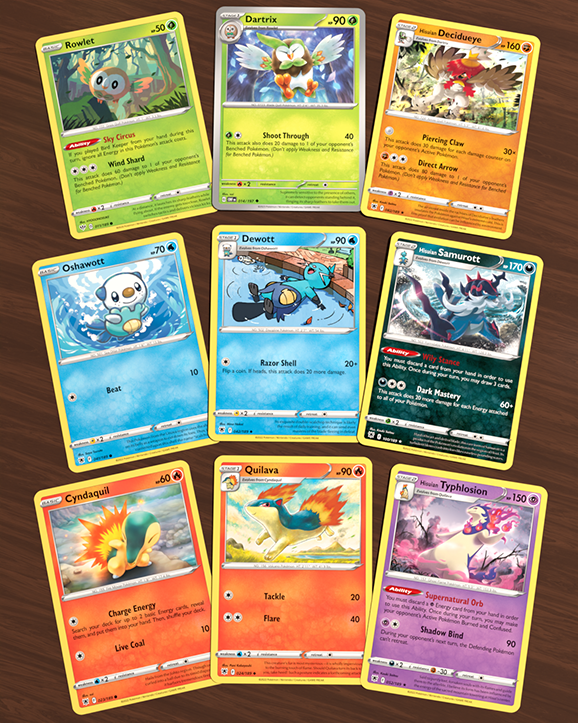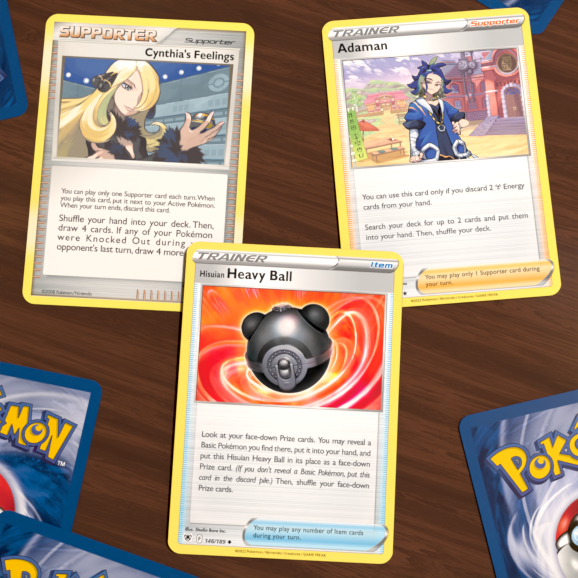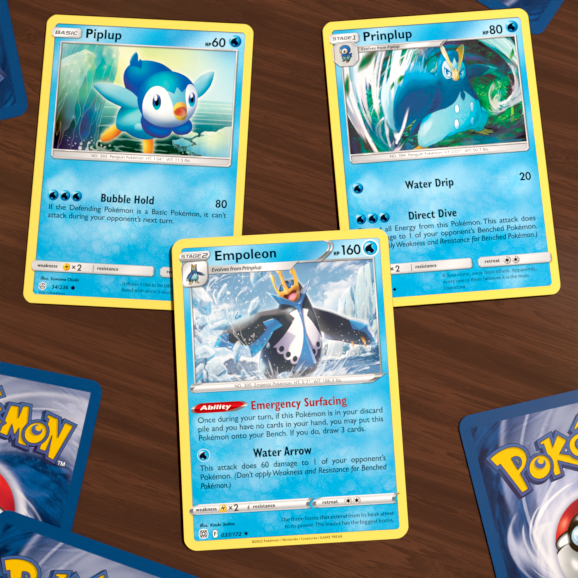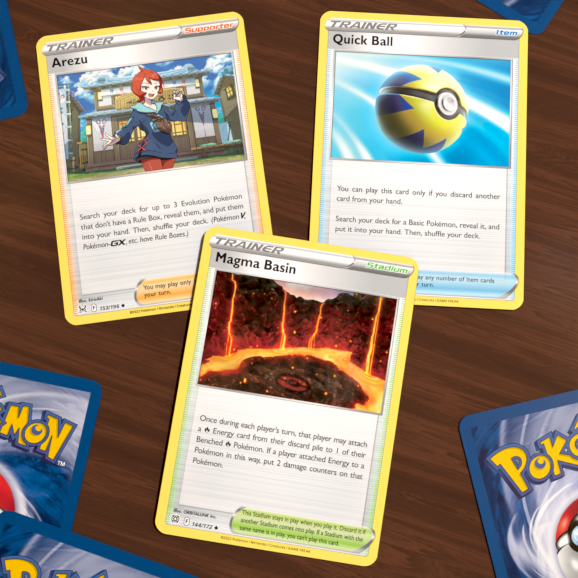The Pokémon Company has revealed how to make a Pokémon TCG cube. Read on below to learn more:
Find out how to start having fun with all the extra cards in your collection by building a Pokémon TCG cube and drafting it with friends.
There are an infinite number of ways to play the Pokémon Trading Card Game—you can play the tried-and-true Standard format, experiment with a wide pool of cards in the Expanded format, or really go off the rails with unique rule sets from a variety of alternative formats, including Gym Leader Challenge, Pack Battles, and more. If you’ve ever thought about creating your own format with a curated pool of cards—maybe you love or loathe specific cards—then creating a cube might be the play for you.
In simple terms, a Pokémon TCG cube is a curated set of cards that interact only with each other; playing a Pokémon TCG cube doesn’t require additional cards for any participant. This is similar to Pokémon TCG products such as Battle Academy and Pokémon TCG Classic, but the difference is that instead of players using preconstructed decks, they draft cards from the cube and build their own decks before battling. “Drafting” is a process by which players pass around a pile or “pack” of cards and take turns picking one card at a time until enough cards have been selected for deck building. It’s a complicated process, so we’ll explain more about drafting later in the article.
The fun thing about building a Pokémon TCG cube is that you make the rules—you choose previously released cards and think about how they might interact with each other when drafted by different players. You can make your Pokémon TCG cube any size you want, but common sizes range anywhere from 240 to 720 total cards. It’s a great way to flex all the extra cards in your collection, and you’ll find that a ton of cards can find new life in a cube setting!
Pokémon TCG cubes have infinite possibilities, but those possibilities come with a ton of questions and even more cards to choose from. Approaching your Pokémon TCG cube can seem daunting, but it becomes more approachable if you start small, focusing on what you want from your card pool. It’s also helpful to consider what cards you already have on hand, since you can tailor the cube in pretty much any way you like. Maybe you’re a fan of a specific type of Pokémon, or you’re looking to emphasize a specific gameplay element (coin flips, anyone?)—try to take Pokémon TCG cube building one step at a time.

For example, we designed a Pokémon TCG cube around Pokémon that appear in Pokémon Legends: Arceus. This established a theme for the Pokémon we’d be selecting, creating a fun parameter to consider when sifting through the card pool. An additional quirk of this choice—which exemplifies that you can add any rule you choose—was to exclude Rowlet, Cyndaquil, Oshawott, and their evolved forms from the drafting pool, and instead have each player select a full Evolution chain featuring one of these first partner Pokémon before drafting.

This theme eventually extended to the Trainer cards—most of the Supporters we selected feature Trainers who appeared in Pokémon Legends: Arceus, as well as the modern-day Sinnoh region of Pokémon Diamond, Pokémon Pearl, Pokémon Platinum, Pokémon Brilliant Diamond, and Pokémon Shining Pearl. And of course, we made sure to throw in some appropriately themed Item, Stadium, and Pokémon Tool cards, too.
When it came to actual rules, our Pokémon TCG cube followed regular gameplay and Standard format rules, with certain cards receiving errata for flavor purposes. For example, we made the decision that Garchomp’s Royal Blades attack would do additional damage if any Supporter card with “Cynthia” in its name was played—and there are a lot of those out there. Be mindful of these types of changes, though—it can be a lot to keep track of for players in your group, and the less knowledge everyone needs to participate, the better.
On that last note, you can also adjust the rules if you think it will make gameplay more fun. Maybe you want to allow the player going first to attack or play a Supporter card on their first turn, or you want to get weird with Evolution rules unique to your cube. This can be a fun part of creating your own cube, too—but be sure to keep the rules written down somewhere!

We also chose to exclude Pokémon with a Rule Box from the card pool, and we mostly limited Pokémon to a single appearance in the cube. For example, the cube includes only one Piplup, one Prinplup, and one Empoleon. It can make drafting a bit chaotic—someone else could easily take that Prinplup you need—but that was the energy that we wanted to carry into the overall gameplay. It makes every choice that much more important!
Not everything can be chaos, though. When building our cube, we were conscious of specific card strengths that might make games less fun. Ensuring that you have a balanced cube is a challenge, but you’ll want to consider how certain cards interact and which combos you want to enable. This part of a cube can always be a work in progress—you don’t have to get it right on the first try, and you can hardly expect to.
This is where the numbers really start to matter. In short, drafting is a process by which players select cards from a common pool. You can use any drafting method you like, but it’s common to create piles or “packs” of cards that are passed around the table from player to player—either clockwise or counterclockwise. The order that these “packs” are passed around in is often alternated to shake up the order of the draft. The number of “packs” (and the number of cards in them) passed around will depend on the number of cards in your cube, as well as the intended deck size for each player. See below for an example of how we drafted our cube:
- Our cube featured 520 cards with eight total players in mind. Not all 520 cards were drafted, but all 520 cards were seen.
- To accomplish this with eight players, we created 40 “packs” of 13 cards, with eight cards drafted from each pack per round. You want to make sure each player ends up with the same number of cards!
- These cards were drafted in a clockwise order, with the starting drafter rotating each round (e.g. P1 drafts first in the first round, P2 drafts first in the second round, and so on).
- The remaining five cards at the end of each round were “burned”—put in the center, unable to be used—before the next round of drafting began.
- Every player ends with 43 cards (this includes the first partner Evolution chain that was selected before the draft) and then builds a 40-card deck for 4-Prize games.
If you’re looking to speed things up, you can instead follow a more traditional draft method:
- Distribute an equal number of packs to each player. In our example above with eight players, that would be five packs for each player.
- Each player drafts a card from their pack before passing the pack to the left.
- Each player will then draft a card from the next pack passed to them. Repeat until the packs only have five cards remaining.
- Once a player receives a pack with five cards, those cards are “burned,” same as the prior method.
- Once each pack has been drafted—and everyone has the same number of cards—proceed to the next set of packs. Be sure to alternate between clockwise and counterclockwise from round to round, and repeat the process until every card has been drafted. In our example, this would take five rounds of drafting.
One of the best things about participating in a Pokémon TCG cube is that everyone is on an even playing field, selecting cards round by round in the hope that they can put together the deck of their dreams. Similar to building a deck for the Standard format, you’ll want to consider specific synergies that cards may have with each other, as well as your Pokémon’s Energy costs.

For example, if you chose Cyndaquil (who eventually evolves into Hisuian Typhlosion) as your first partner in our Pokémon TCG cube, you can start your drafting strategy by prioritizing Pokémon with ![]() in their Energy costs, as well as cards that support Psychic-type Pokémon. You can also look for Pokémon that synergize with Hisuian Typhlosion’s Supernatural Orb Ability—like Roserade or Parasect. Things might not always go your way, so be prepared to pivot toward a different strategy if other players are grabbing all the cards you want!
in their Energy costs, as well as cards that support Psychic-type Pokémon. You can also look for Pokémon that synergize with Hisuian Typhlosion’s Supernatural Orb Ability—like Roserade or Parasect. Things might not always go your way, so be prepared to pivot toward a different strategy if other players are grabbing all the cards you want!

Don’t forget to pick up those Trainer cards—they’ll help you execute your strategy, and they’re usually few and far between in Pokémon TCG cubes. Item cards and Supporter cards are always at a premium, and you’ll need to balance how often you draft them while building out your Pokémon Evolution chains. If you’re feeling particularly mischievous, you can also draft Trainer cards (and Pokémon) that you know you won’t use, just to take them away from your fellow players.
Feedback is also an important part of the cube gameplay experience. If it’s your cube, it’s good to chat with your friends afterward about what cards worked and what cards didn’t; you might just find a new perspective that you didn’t previously consider. If you’re participating in someone else’s cube, you might be the one to offer that perspective instead. As we mentioned earlier, balancing a cube is difficult, but you don’t have to do it all on your own.
Pokémon TCG cubes are a fun, “living” way to play the Pokémon TCG because you can always play it again and add new cards on a whim. Between the large card pool, the natural variance that occurs in drafting, and any adjustments you make to your own cube list or rules, there’s a ton to explore and enjoy each time. Maybe you want to focus on a different Energy type after one let you down? Or you’re sure that you’ll get that combo off this time. Even if you choose to pursue the exact same strategy, it’s more than likely you’ll have a different experience one way or another.
If you want to check out our cube list, you can see the current 540-card version (we’ve already made a few changes since writing this article) as a PDF here. Good luck on your cube journey, Trainers!
Source: Pokemon.com
Source: Pokemon

